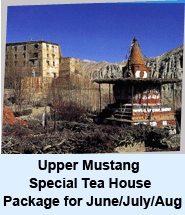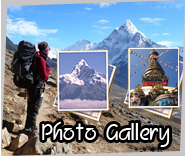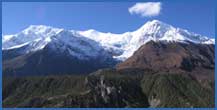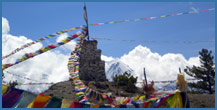Once is Not Enough for Naturally Nepal
Trekking in Nepal
Tour in Nepal
Nepal General Information
Nepal is a small but beautiful country. We can say " Nepal is a gourd between two rocks." It lies between two big countries India and China. Total area of Nepal is 1,47,181 Sq. Km. The population of our country is about 26 millions. Nepal , being a land-locked south Asian country, bordered by Tibet- China to the north and India to the east, west and south. Nepal is a country of diversity beyond of her small boundary. People of different casts live in Nepal.. Most of them are Hindus and other are Buddhists, Christians and Muslims. Physically, Nepal can be divided into three parts, Himalayas, Mountain and Terain . All kinds of people from any parts of the world, therefore, can adjust in Nepal from the view of climate.
The altitude of Nepal varies from 70 meter to the highest world peak point 8,848 meter( Mount Everest). Nepal is rich natural beauty like snow capped mountains, beautiful lakes, wild animals, green forests, rivers, valleys, ancient temples, historical places etc. This country, therefore, is a natural gift. In addition, more than sixty different indigenous ethnic group of people and their distinct rich culture and religion make Nepal like a garden with various flowers. The greatest peak of the world- Mt Everest, Innumerable rivers, lakes and water-fall fascinate everyone. The beautiful rice fields, terraces, majestic snow-capped mountains, green forests,valleys , innumerable monument and friendly behavior of the people are ever unforgettable. All these things, therefore, will definitely make your visit unforgettable for you entire life.
History
Nepal’s ancient historical data tell us that the first rulers of Nepal, which then comprised the Kathmandu valley, were the Gopalas, followed by the Mahishapals, succeeded by the Kirants, the Licchavis, the Mallas and finally the Shah dynasty. Prithvi Narayan Shah launched his integration campaign and brought under his rule most of the independent principalities. His successors completed the task and Nepal finally became one nation under the Shah dynasty. Unfortunately for them, the Rana Prime Ministers then usurped power from the ruling family and ran the affairs of the country for 104 years from 1846 to 1951. The monarchs of Nepal became mere figureheads, while the Ranas enjoyed all the power, wealth, pomp and ceremony. The Shah dynasty was powerless, but retained the status of a royal family. The Ranas then closed the country to all foreigners except for the few who entered the kingdom on their invitation. Finally King Tribhuvan escaped to India with most of his family and the people revolted, leading to the ouster of the Rana regime. In 1951, the king flew back to Nepal to a warm welcome from the citizens and introduced democracy. Since then the borders of Nepal have been open and tourism was introduced to Nepal
King Mahendra who succeeded King Tribhuvan, abolished democracy, banned all political parties and introduced the Panchayat system. After the major party leaders were jailed, King Mahendra’s appointees ran the autocratic Panchayat government. A more lenient ruler, King Birendra ascended to the throne in 1975, succeeding his father, King Mahendra. But although popular with his subjects, the winds of change blowing over from Europe forced King Birendra to give in to demands for a democratic government in 1990. An elected government took charge of the state’s affairs with the king as a constitutional monarch and head of state. Then followed the infamous palace massacre of 2001, that did away with the entire ruling family leaving behind only the family of the king’s brother, Gyanendra Shah, who was then crowned king of Nepal. But King Gyanendra soon took over absolute power by removing the Prime Minister and appointing his own hand-picked ministers. However, this wasn’t to last long, as all political parties including the Maoists joined hands to rise up against him. King Gyanendra was forced to step down and stripped of all his powers. Immediately after democracy was reinstated in April, the Maoists announced a cease-fire. The government, under Girija Prasad Koirala, responded with their announcement of a cease-fire. After about 6 months of peace talks, the head of the government, Girija Prasad Koirala, and the chairperson of Maoist party, Puspa Kamal Dahal, ( Prachanda), signed a peace agreement on 21 October 2006. The Polls for the Constituent Assembly held on April 10, 2008 where Maoists achieved a majority in the elections. A month later parliament abolished the monarchy, declared as a republic nation, ending 240 years of Shah dynasty rule.
Geography and Population
Although Nepal is a small country of only 147,181 square km, it contains the greatest altitude variation on earth, from the lowland Terai, almost at sea level, to Mt. Everest, which at 8848 meters is the highest point on earth. The country is about 800 km. long and from 90 to 230 km wide. A cross-section shows four main areas to the country. Close to the border with India is a low fertile strip of jungle land known as the Terai.
Above the Terai rise the Siwalik foothills and beyond them the higher Mahabharat range. Most of the population of Nepal is found in the fertile valleys, such as Kathmandu Valley and the Pokhara Valley. These are north of the Mahabharat range at an altitude between 1000 and 2000 meters. In the north, in the higher altitude Himalayan range form a border between Tibet and Nepal.
Climate and Rainfall
Nepal has four distinct seasons. Spring, from March to May is warm and dusty with rain showers. Summer, from June to August, is the monsoon season when the hills turn lush and green. Autumn, from September to November, is cool with clear skies, and is the most popular trekking season. In winter from December to February, it is cold at night and can be foggy in the early morning but afternoons are usually clear and pleasant, though there is occasional snow in the mountains.
Weather condition in Nepal vary from region to region. Summer and late spring temperatures range from more than 40 Degrees Celsius in the Terai to about 28 Degrees Celsius in the hilly region of the country. In winter, average maximum and minimum temperatures in the Terai range from a mild 23 Degrees Celsius to a brisk 7 Degrees Celsius while the central valleys experience a chilly 12 Degrees Celsius maximum temperature and a minimum temperature often falling below freezing point.
Much colder temperatures prevail at higher elevations. The Katmandu Valley situated at an altitude of 1310m, has a seasonable but equable climate with average summer and winter temperatures of 27 Degrees Celsius to 19 Degrees Celsius and 20 Degrees Celsius to 2 Degrees Celsius respectively. The annual rainfall in Katmandu generally exceeds 1300mm. The mean annual precipitation ranges from more than 6000mm along the southern slopes of the Annapurna range in central Nepal to less than the 250mm in the north central portion near the Tibetan plateau. Amounts varying between 1500 and 2500mm predominate over most of the country. On an average, about 80% of the precipitation is confined to the monsoon period (June-September).
Culture
Crooked, timeworn streets flanked by irregular, multi-roofed pagodas, stupas and stone sculptures, and into rooms cluttered with horror-eyed masks, spinning prayer wheels, trippy thangka scrolls and Tibetan carpets. Muttered chants, esoteric tantric hymns and Nepalese music hang in the air, whether it be the twang of a four-stringed saranghi or the plaintive notes of a flute.
Traditional folk musicians, or Gaines, gather for an evening of singing and socialising; classical dancing and trance-like masked dances enliven the Kathmandu Valley and Bhaktapur regions; while no wedding would be complete without the raucous Damais - Nepal's modern ensembles.
Religion is the lifeblood of the Nepalese. Nepal was declared a secular state by the parliament following the reinstatement of democracy in April. However, there has been a demand by some people to declare it a Hindu state like it previously was. Though many people are Hindus, there are many who practice a syncretism of Hindu and Buddhist beliefs. The population that isn't Hindu or Buddhist is Muslim, Christian, Sikh, or shamans.
While the food acclaimed as ‘Nepali’ and served in restaurants is Dal-bhat-tarkari (rice, lentil soup and curried vegetable) with some pickle. Most of the time meals of the affluent Bahun Chetris and Newars are Dal-bhat-tarkari, this is hardly the makings of nepali people’s food and is definitely not what all Nepalese eat. Nepal has as many types of food as ehnic groups. Even when you eat the same old Dal-bhat tarkari, here can be so many types of vegetables you can eat, cooked in so many different ways. Some famous foods are Sel roti.
In Kathmandu, food native to any part of the world is available. Along famous trekking routes With any (or all) of these food, you can have a lassi, locally produced beer, or Chang, which is a brew made from barley, mainly in the mountains.
Does & Don’t
Nepal’s has unique culture and its so astounding, surprising mystical , that some tips for newcomers are sometimes necessary.
• To show appreciation and respect, use two hands rather than one when giving or receiving something, even money.
• Remember not to point with a single finger but use a flat extended hand especially to indicate a sacred object or place.
• Among Hindus, avoid touching women and holy men. The traditional palms-together "Namaste" greeting is preferable.
• Don't eat with your left hand nor eat beef among Hindus.
• Try not to step over or point your feet at another person, a sacred place or a hearth.
• Remove your shoes when entering a home , temple or monastery ( and leather items in Hindu temples ) and avoid smoking and wearing scant dress in religious settings.
• Do not offer food from your plate, nor eat from a common pot, and avoid touching your lips to a shared drinking vessel.
• The sight of men holding hands is common, but men and women holding hands, and general acts of affection, are frowned upon.
• Ask for permission before taking pictures, specially inside holy shrines and temples










